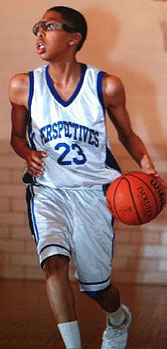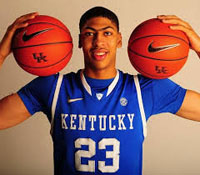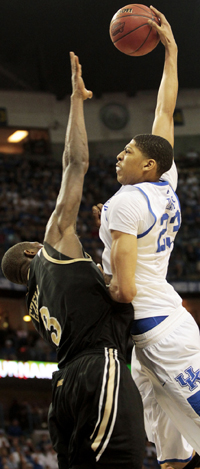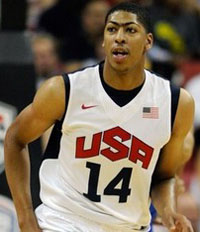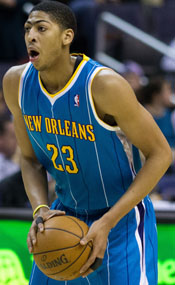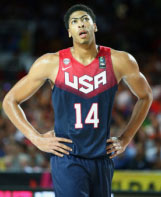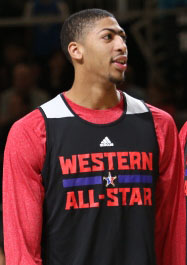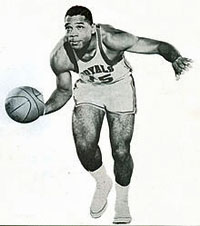
Wayne Embry
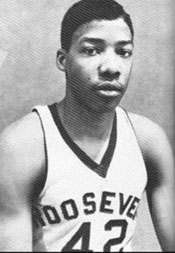
Julius Erving, Roosevelt HS
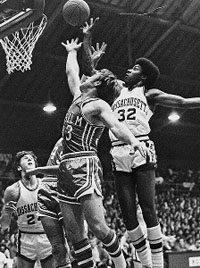
Julius Erving in college

Erving with Squires

Artis Gilmore
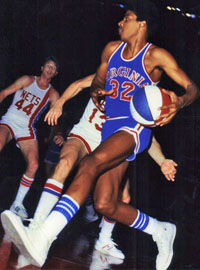
Erving with the ABA's red, white, and blue ball
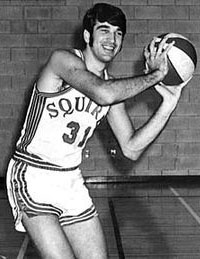
George Irvine
|
Julius Erving - I
Wayne Embry, a twelve-year NBA center, recalled his first meeting with Julius Erving.
- It happened at a summer basketball camp in upstate New York where Embry worked.
- One afternoon, Wayne wanted to shoot some, then run a few miles. A coach at the camp asked him if he wanted some competition. Thinking there was no one in the camp that could compete with an NBA player, Embry deferred.
- But the coach kept pressing. I have this kid here, and he'd really love to play you.
Is he a college player?
No, he's just out of high school.
Nah, I don't think so.
- The coach persisted and Embry gave in. So the coach brought out a skinny 6'5" kid who introduced himself as Julius Erving, which meant nothing to Embry. Thinking he'd give the kid a break, Wayne promised he would take all his shots outside the foul line.
- Wayne recalled: Those were the rules. I had to shoot outside and the kid could do whatever he wanted, which is exactly what he did to me - whatever he wanted. He was absolutely phenomenal. I kept looking at him and couldn't believe he was a high school kid. His hands weren't just big, they were enormous.
- We played another game, same rules, and I got my butt kicked again. For the third game, I said, I'm going inside. I was going to muscle this skinny kid, but I couldn't catch him. He drove around me, he dunked over me. So that was it. I was an NBA center and I had lost to a high school kid. Later that day, Johnny Green wanted to play me. Johnny was also working the camp and he was a very good player for the Cincinnati Royals. By this time, Julius had worn me out and I told Johnny that I was tired. Then I said, "Johnny, I got somebody for you."
- Erving kicked Jumping Johnny Green's butt too.
Raised in Nassau County on Long Island, NY, Erving began attracting attention in the Rucker Park league in Harlem.
- People called him "Black Moses" and "Houdini." But Julius preferred "Doctor," a name that a high school friend of his had given him. Soon the nickname evolved into "Dr. Julius."
- Coming out of high school, he didn't gain the notice of many colleges. So he signed with the University of Massachusetts.
- After sitting out his freshman year as required by NCAA rules at that time, he led the varsity Redmen (as they were called then) to an 18-6 record and a berth in the 1970 NIT (the same tournament that Pete Maravich played in).
Erving finished with 18 in the opening round game against Marquette, which prevailed 62-55.
- In his junior season at UMass, Julius was the second leading rebounder in the nation and repeated as Yankee Conference scoring champion.
- With a 23-3 record, the Redmen again made the NIT, but this time fell to North Carolina 90-49 in a game in which Erving was tagged with four fouls before halftime and got the fifth with 16 minutes left in the game. He scored just 13 points with nine rebounds.
- Despite the two post-season appearances, few basketball writers and fans outside of New England knew about Dr. Julius.
- He still holds numerous records at UMass:
Most points in a half - 29
Most points in a game by a sophomore - 37, which he did three times
Most points in a season: 727 (1970-71)
Single season points per game: 26.9 (1970-71)
Games of 20 or more points in a season: 23
- in both 1969-70 and 1970-71
Consecutive 20-point games: 18 (1969-70)
Average points per game for a career: 26.3
Consecutive games in double figures: 52
Most free throws made in a game: 19
Most rebounds in a game: 32
Most rebounds in a season: 527
Rebounding average for a season: 20.9
(1969-70)
Double-figure rebounding games in a season and career: 26 and 51
Career rebounding average: 20.2
Consecutive double-figure rebounding
games: 51
After talking to agent Steve Arnold, Erving decided after three years of college that he was ready to try pro ball.
- His announcement a week after the NIT game against UNC didn't attract much attention except in a few front offices of the American Basketball Association. NBA policy prevented teams from drafting players until four years after they left high school. However, the ABA had no such rule.
- Julius Erving may not have been a household name across the basketball landscape, but many pro scouts knew how good a player he was. One was quoted as saying that Erving was "the best junior in the United States." Another branded him "one of the three best forwards in the nation." All this despite the fact that college rules prohibited dunking the ball, which took away what would prove to be Julius's main claim to fame.
- One person who knew of Erving's ability was Earl Foreman, the owner of the Virginia Squires of the ABA. After Arnold praised his client to him, Earl contacted a coach he trusted in Maine. The coach told him, Forget Cousy, forget everybody. Julius Erving is the greatest basketball player ever to come out of New England.
- The Virginia GM, former NBA player Johnny Kerr, was also impressed by Julius. Even at 20 years old, he was calm, mature and totally in control. He said his mother had some health problems and it was his turn to help support the family. ... It was his hands that I'll never forget. I never saw such long fingers. They were the fingers of a pianist or a surgeon.
- Erving recalled: I felt I had accomplished all I could in college ball and I was ready to turn pro. Virginia was interested in me and I was interested in talking to them ...
- The result was the Squires signed their first undergraduate player April 5, 1971. In announcing the deal, Foreman tried to fend off criticism for luring a young man away from college. We are as anxious as anyone to see the young man finish college. He is an intelligent young gentleman who wanted to play professional basketball. We did not influence him to sign, but we are pleased he selected the Squires. Erving's contract included a clause that assured him a bonus when he received his degree (which he eventually obtained).
- The contract called for $500,000 for four years. Each year, Erving received $75,000 in cash with about $50,000 deferred and paid out over seven years.
The Doctor energized the ABA and helped keep it afloat financially.
- Virginia coach Al Bianchi admitted he didn't really know what he had in Erving. He told reporters that Julius could rebound and had big hands. Bianchi called his old college coach, Tex Winter, who told him, That kid is really talented, but it's raw talent. Not a great shooter, not a real good ballhandler. But he is very explosive to the basket. He could end up being very good down the line.
- Julius impressed his teammates and coaches during the first scrimmage of preseason camp. Kerr: ... a shot banged against the back of the rim and went straight up. It was one of those rebounds where it seems that all five players were jumping for it. Out of the middle of the pack came Julius ... up ... up ... up. He cupped the rebound with one hand and then slammed it through the rim, all in one motion. The gym went silent. All the players just stopped for a few seconds. This was a tryout camp and I had just watched one of the best plays I had ever seen in my life. ... It wasn't long after that when I told some of the writers who covered the Squires, "You guys are going to think I'm crazy, but one day Julius Erving will be going into the Hall of Fame."
- In the first exhibition game, Erving did the unthinkable. He dunked on C Artis Gilmore of Kentucky. Colonels' coach Joe Mullaney described the play: He went right over 7-foot-2 Artis Gilmore and dunked on him. On another play, Julius drove the baseline, Artis came over for the block and Julius just floated past him in the air, under the basket, and then made a reverse layup.
- The rookie proved Winter a prophet by leading the league in offensive rebounds but also in turnovers. He averaged 27.3 ppg and 15.7 rpg and made the ABA All-Star team.
- Bianchi: When I coached, I hever had a bench that was more attentive than when Doc played for me, because the guys wanted to watch the game to see what he would do next.
- Virginia swept The Floridians in the first round of the playoffs before losing to the New York Nets in the Eastern Division Finals. Five of the seven finals contests drew more than 10,000 fans.
- Erving scored at a higher clip in the playoffs than in the regular season - 33.3 for eleven games.
Erving did even better his second season.
- He averaged 32 points, 12 rebounds, and 50% shooting. Dr. J was a drawing card throughout the league. Fans came early to watch warmups.
- Teammate George Irvine: One time in warm-ups, Julius was doing his thing where he'd throw the ball off the backboard, grab it with one hand and dunk back over his head. It was a totally new dunk for him or anyone else. I said, "Doc, where did you come up with that one?" He said, "Last night, I had a dream and I saw myself do it. I never tried it until today." I thought, "Man, this guy even dreams about dunking." In the layup lines, no one wanted to go behind Doc. He'd do one of his indescribable dunks then I'd come along and do a little wimpy jam and the fans would get on me. After that happened once, I always made sure that I dunked in front of Julius.
- The Squires made the playoffs again but lost to the Colonels in five games in the opening round.
Before the 1973-74 season, Erving becomes embroiled in a contract controvesy involving both rival leagues, the ABA and NBA.
Reference: Loose Balls: The Short, Wild Life of the American Basketball Association as Told by the Players, Coaches, and Movers and Shakers Who Made It Happen, Terry Pluto(1990)
Continued below ...
|
The American Basketball Association tried to promote Julius Erving as much as possible. Johnny Kerr, the GM of the Virginia Squires, for whom Erving played from 1971 to 1973:
We tried to promote Julius as much as possible. We had a Doctor Night where everyone with a medicine bag or a stethoscope got in for a buck. We dressed Julius like a doctor for a life-sized poster. The Doctor J nickname was a public relation man's dream. ... A young Julius Erving was like Thomas Edison. He was inventing something new every night.
After his sensational rookie season with the Squires, Erving asked owner Earl Foreman to move up some of the deferred money ($50,000 of the $125,000 paid annually for four years).
- Earl expressed willingness to make some adjustments.
- However, the inexperienced Erving made a mistake. He told Foreman he did not plan to spend his whole career with Virginia and would probably move elswhere when his contract expired.
- Foreman reacted by pulling his offer off the table.
So Julius's new agent, Irwin Weiner, began talks with the Atlanta Hawks, who had lost Zelmo Beatty and Joe Caldwell to the ABA.
- Erving signed a contract with the Hawks before the 1972 NBA draft, for which he was now eligible because his college class was graduating.
- Atlanta didn't have a first round pick, and they thought no one else would select Julius because he already had a contract with them.
- But the Milwaukee Bucks selected him with the second of their two first round picks.
The Bucks GM was none other than Wayne Embry, a former NBA C whose butt Erving had kicked as a fresh high school graduate working at a summer camp in
upstate New York.
- The Squires owner had told Julius he would go to court when he heard about the Atlanta contract. So now teams in both leagues were fighting over the rights to Doctor J.
- The NBA office ruled in favor of the Bucks but not before Erving played two exhibition games with the Hawks. Atlanta also had to give Milwaukee two second-round picks and $250,000.
That Hawks team included Pete Maravich and Lou Hudson. One can only wonder how good they would have been with Erving.
- A Federal judge in Virginia told the two sides to go to arbitration to settle the dispute. In the meantime, Julius had to stay with Virginia.
- Foreman: I admired Julius's attitude. In effect, he lost. But he was a man about it .... Julius had a great second year for us while his case went to arbitriation. The off-the-court stuff never bothered him. He was classy in every way.
- No one won the arbitration because, before the ruling came down, the Squires traded Erving to the New York Nets, whose owner, Roy Boe, gave him a new contract.
- Foreman: Roy Boe and the Nets desperately wanted Julius. They knew he had star quality and would be a terrific headliner for the entire league while playing in the New York market. When I mentioned that I had to sell Julius, Roy Boe couldn't write a check fast enough.
- Squires coach Al Bianchi summarized the deal like this: Obviously, it broke my heart when we had to sell Julius to New York after his second year. But we didn't have the money to pay him, and he was on the verge of going to Atlanta. The last thing we wanted was to lose him to the NBA. So I was glad he stayed in the league, even if it wasn't with me. It's fun to say that I saw Julius when he was a young colt in pro basketball, just getting his legs under him - and what legs they were! Unless you saw Julius in the ABA, you never really saw his high-wire act. He was a better overall basketball player later in his career, but he was more exciting with us and in his first few years with New York.
Acquiring Erving paid dividends for Boe's franchise immediately.
- After going 30-54 in 1972-73, the Nets leaped to 55-29, the best record in the league, and won the ABA Eastern Division. The team struggled out of the shoot, going 4-10 as the new players learned to work together.
- First year coach Kevin Loughery's club eliminated the Squires 4-1 in the conference semifinals, then swept the Kentucky Colonels to earn a trip to the Finals.
- The Utah Stars didn't mount much opposition in the finals, falling in five games.
- Julius led the Nets in FG% (.512), 3-point FG% (.395), FT (454) and FTA (593), and points (2299, more than 900 ahead of the next best).
- He topped the entire league in FGA, 2-point FG attempts and made, and points. Of course, he won the MVP award, the first of three in a row.
- Nets' home attendance at the Nassau County Coliseum jumped from 6,735 average to 8,923
- Loughery: When Julius came to the Nets from Virginia, the word was that he could do things that had never been done before on the court. I was in the NBA, so I hadn't seen him with Virginia. You hear things about a guy and you say, "Yeah, right." Hey, I had been watching the world's greatest payers in the NBA, so I had some real doubts that Virginia was going to show me something I had never seen before.
In the first game that I coached Virginia with the Nets, he had the ball right at the end of the first half. We were playing Indiana and the clock was running down. Doc drove the baseline and found himself under the basket with ... two big guys going for the block. Somehow, Doc floated between McGinnis and Hillman and then almost tore down the rim with a slam. To that point in my life, that was the greatest dunk I had ever seen, and Doc did it in the first half of my first game with him. After that, there were a lot of "greatest dunks" when you watched him every day.
What impressed me even more was there here was a player who really was the league. He could have done almost anything he wanted, but Doc never missed a game and never even missed a practice in his three years with me. ... I would ask him, "Doc, want to rest your legs?" He was playing 40 minutes a night. But he'd always play. He loved the game, and he'd play so hard in practice that he'd lift the rest of the team. He was usually the last guy to leave practice, because he was always asking somebody to play him 1-on-1.
Home attendance climbed to 9,135 in 1974-75.
- The Nets actually won more games (58) but finished in a tie with the Kentucky Colonels for the top spot in the East.
- The Colonels, led by Artis Gilmore and Dan Issel, won the onegame tiebreaker, 108-99.
- Then the unthinkable happened. The Spirits of St. Louis, who finished 26 games behind the Nets, had lost all 11 regular season matchups between the two teams by an average of 17.3 ppg. But after losing the opener to stretch the losing streak to 12, the Spirits rolled off four wins in a row to eliminate the Nets.
- St. Louis won the final game on the road in dramatic fashion thanks to a miscue by the Nets' star. With only 20 seconds left, New York led by one and had possession. The inbounds pass from midcourt went to Erving. Guarded closely, Julius dribbled the ball off his leg into the back court. The violation gave the ball to the Spirits, who took advantage of the break. Freddie Lewis sank a jumper from the top of the key with three seconds left.
The Nets "slumped" to 55 wins in '75-76.
- Regular season attendance dropped to 7,755, a decline that reflected what happened across the league.
- Erving scored a personal best 2,462 points or 29.3 per game.
- With the league trimmed to nine teams, the ABA didn't divide itself into East and West.
- The Nets finished in second place, 5 games behind the Denver Nuggets.
- The top four made the playoffs, and the Nets defeated the San Antonio Spurs in seven games to go to the finals, where they beat the Nuggets in six as Erving averaged 34.7.
- Julius had led New York to 168 regular season wins and two championships in his three years with the club.
Steve Jones, who played for seven different ABA team, summarized Erving's development during his five years in the ABA.
Julius was hardly a finished product when he came into the ABA. He was strictly an over-the-rim player, a pure athlete, and his greatest attribute was offensive rebounding. But he worked on his game, developed a jumper and some drives, to the point where he could make a shot from any angle.
The storm clouds that had been hanging over the ABA for several years finally released the downpour that drowned the league.
Reference: Loose Balls: The Short, Wild Life of the American Basketball Association as Told by the Players, Coaches, and Movers and Shakers Who Made It Happen, Terry Pluto(1990
To be continued ...
|
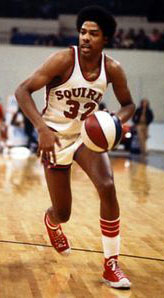
Julius Irving, Virginia Squires
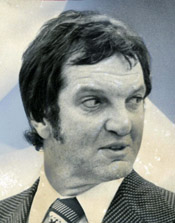
Earl Foreman, Squires owner
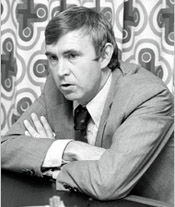
Roy Boe, Nets owner
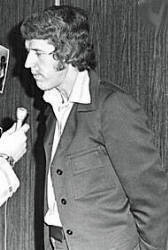
Kevin Loughery
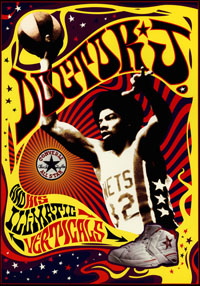
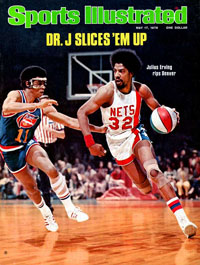 
Artis Gilmore (53)
|
Julius Erving - III
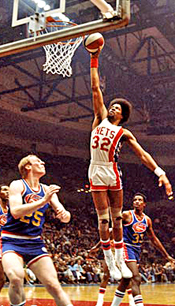
Julius Erving in the ABA
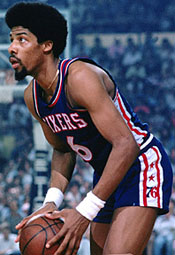
Dr. J in the NBA
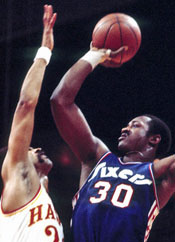
George McGinnis
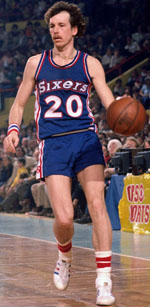
Doug Collins
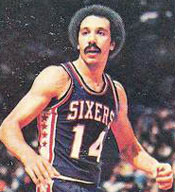
Henry Bibby
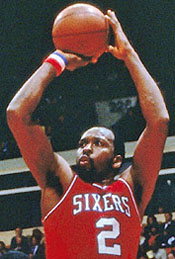
Moses Malone
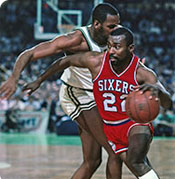
Andrew Toney
|
Following the lead of the American Football League, which eventually won a merger with the National Football League, the American Basketball Association yearned to become part of the National Basketball Association.
- By the 1975-76 season, however, the ABA was hanging on by its fingernails.
- Before that season, the Denver Nuggets and New York Nets applied to join the NBA.
- Ultimately, both teams were forced by court order to play a lame duck season in the ABA.
The ABA almost didn't make it through the '75-76 season.
- The Memphis Sounds moved to Baltimore as the Claws but folded after three preseason games. (With such a yukky color, the Claws deserved to fold.)
- Three weeks in to the new season, the San Diego Sails bit the dust when the owner learned his team would be barred from joining the NBA by Jack Kent Cooke, owner of the Lakers.
- The Utah Stars, once one of the ABA's strongest franchises, went belly up December 2 after owner Bill Daniels ran out of money following his unsuccessful campaign to become Governor of Colorado. Most of the Stars' players were sold to the St. Louis Spirits. Twelve players from the Spirits would play in the NBA during the 1976-77 season.
- With the ABA down to seven teams, the league abandoned divisional play.
- Although they finished five games behind the Nuggets in the final standings, the Nets, led by Julius Erving, won the four-team playoff to claim the final ABA crown.
Eventually, four ABA teams were accepted into the NBA.
- One of the teams moving to the older league was the New York Nets, who had survived because of Dr. J's magnetism.
- Each of the four newcomers had to pay a $3.2M "expansion" fee to the NBA. In addition, the Nets had to fork over $4.8M to their in-town rival, the New York Knicks, as compensation for having invaded their territory
- To help defray this debt, Nets owner Roy Boe offered his most valuable commodity, Julius Erving, to the Knicks in lieu of paying the $4.8M penalty. However, in a decision that is still debated today, the Knicks refused the offer.
- Instead, on October 20, 1976, the Nets sold Julius to the Philadelphia 76ers for $3M.
- The bottom line was that the Nets traded their franchise player for a place in the NBA.
- Boe: The merger agreement killed the Nets as an NBA franchise. I also owned the New York Islanders hockey team, so I had a lot of financial responsibilities. But to be hit with $3.2 million to get into the NBA ... I needed to get some cash, about $ million, by September 15. And Julius Erving said he wanted a new contract. He was making $350,000 with several years to run. Julius said that we made him a promise that we'd renegotiate his contract if we got into the NBA. Well, he had a 60-some-page contract and there wasn't a word in there about that. I offered Julius to the Knicks for a cash settlement and in exchange for dropping that $480,000-a-year indemnity charge. They turned it down. I didn't have the $3.2 million in liquid cash to get into the NBA and it was due on September 15. I was offered $3 million for Julius from Philadelphia and I took it, because I had no choice. The merger agreement got us into the NBA, but it forced me to destroy the team by selling Erving to pay the bill.
- Erving: In general, the ABA players felt as if we were sold down the river by the merger. At the very best, we got a second-rate deal from the NBA and not nearly the respect that we deserved. Guys lost jobs because three teams didn't get in. Other guys lost benefits or had their contracts broken. For years, we stood together against the NBA. To have the whole thing come apart like that - it really hurt.
Ask youself this: Who made out?
The ABA owners got a good deal because by getting into the NBA, their francises increased in value. In the long run, they got more than just their money back from the fee they paid to get into the NBA.
The ABA owners who didn't get in received incredible financial settlements.
The NBA owners got a great deal. They got all the money from the ABA teams, who wanted to get into the NBA. But they also got all the best ABA players, which made the NBA a more exciting and popular league.
But what happened to the average ABA players? Most didn't get jobs or played maybe a year or two in the NBA. They basically were left out in the cold.
Dr. J joined an already-talented Philadelphia team.
- His companion F was George McGinnis. Doug Collins, Henry Bibby, and World B. Free manned the backcourt. The C was Caldwell Jones, with rookie Darryl Dawkins learning the ropes.
- Julius led Gene Shue's club in minutes played and points and ranked second to McGinnis in rebounds.
- The 76ers improved from 46-36, 2nd in the Atlantic Division, in 1975-76 to 50-32 and a first place finish in the Atlantic Division.
- They defeated their hated rivals, the Celtics, in the first round of the playoffs before knocking off the Houston Rockets to win the Eastern Conference and make the NBA finals for the first time since 1966-67 when a guy named Wilt Chamberlain roamed the middle.
Erving played the rest of his career with Philadelphia until retirement after the 1986-87 season.
- While not dominating the NBA as he had the ABA, he provided an important piece to a franchise that made the playoffs the first eleven years of his tenure.
- The Sixers made three more trips to the finals, losing to the Lakers (led by a rookie named Magic Johnson) in 1980 and again in 1982 before finally besting Los Angeles for the 1983 championship.
- At age 32, Julius finished third on the title team in scoring beind C Moses Malone and G Andrew Toney and a distant second in rebounding to one of the greatest board men in NBA history, Malone.
In 1984, the 76ers offered an aging Julius Erving to the Chicago Bulls for their #2 pick in the NBA draft. With Portland having already decided to take Sam Bowie at #1 - and thereby become the answer to the question, "What is the biggest mistake in NBA draft history?" - the Bulls were expected to pick Michael Jordan. Of course, Chicago turned down Philadelphia's offer.
Julius retired at age 36 with these combined statistics from the ABA and NBA.
- 1243 games
- 30,026 points or 24.2 ppg, good for 9th place on the ABA/NBA list when he retired (now 20th)
- 10,525 rebounds
- 5,176 assists
Erving was inducted into the Basketball Hall of Fame in 1993.
In addition to revolutionizing the game with his above-the-rim feats, Dr. J. single-handedly kept the ABA alive its last several years so that four of its teams could join the NBA. So you fans of the Nuggets, Nets, Pacers, and Spurs, thank Dr. J that you have a team to root for.
Let's let the NBA Encyclopedia at nba.com have the final word.
Julius Erving, the great and wondrous "Dr. J," was the dominant player of his era, an innovator who changed the way the game was played. He was a wizard with the ball, performing feats never before seen: midair spins and whirls punctuated by powerful slam dunks. Erving was one of the first players to make extemporaneous individual expression an integral part of the game, setting the style of play that would prevail in the decades to follow. A gracious, dignified, and disciplined man, Erving was the epitome of class and an ideal ambassador for the game.
|
Reference: Loose Balls: The Short, Wild Life of the American Basketball Association as Told by the Players, Coaches, and Movers and Shakers Who Made It Happen, Terry Pluto (1990)
The Book of Basketball: The NBA According to the Sports Guy, Bill Simmons(2009) |

Dave Bing, Syracuse

Dave Bing, Pistons

Mayor Dave Bing |
When Detroit's mayor resigned in September, 2008, following his plea of guilty to perjury charges, the man who won the special election to replace him was Dave Bing. Bing, a highly successful businessman, had been a basketball star both in college and the NCAA.
- Despite blurry vision in one eye as a result of a childhood accident, Bing played basketball at the same high school where Elgin Baylor matriculated. Dave made the 1962 Parade magazine All-American team.
- Bing earned a basketball scholarship to Syracuse, where his roommate was future Orange coach Jim Boeheim.
- He led Syracuse in scoring all three years he was eligible. His senior year, he ranked fifth in the nation in scoring and became the school's first consensus All-American in 39 years.
- The Detroit Pistons selected Bing with the second pick in the 1966 NBA Draft. He made NBA Rookie of the Year for the 1966-7 season.
- He led the league in scoring with a 27.1 average in 1968.
- During ten years with the Pistons, Dave played in seven All-Star games. For his career, he averaged 22.6 points and 7.8 assists.
- He spent two years with the Washington Bullets and one with the Celtics before retiring in 1978.
Bing became a highly successful businessman after retiring from the NBA.
- In 1980, Bing opened Bing Steel in Detroit.
- Four years later, he was named the National Minority Small Business Person Of The Year by the Reagan administration.
- Bing became one of the few former pro players to earn more in his business career than he did in the NBA.
After turning down numerous invitations to enter politics, Dave decided in 2008 that Detroit needed him. His fame helps him get things done where other politicians fail.
Reference: "Having Fun Yet, Mr. Mayor?", Michael Rosenberg, Sports Illustrated, 1/18/2010
|
Poor Dave Meyers. He was a fine player for UCLA and had a five-year NBA career. But he's spent his life in the shadow of his younger sister, Ann, who was one of the first superstars of women's basketball, also playing for UCLA.
There was no way the Bruins were going to lose Wooden's final game.
- UCLA defeated the Wildcats 96-85 as Meyers tallied 24 points and 10 rebounds, second only to sophomore Richard Washington's 28/12.
- For the season, Dave led the team in scoring (18.3) and rebounding (7.9) to earn co-Player of the Year in college basketball. His career was rewarded with induction into the UCLA Athletics Hall of Fame in 1992.
- Ann Meyers came to UCLA as a freshman when Dave was a senior. She would lead the Bruins to the 1978 championship of the Association for Intercollegiate Athletics for Women. She still holds the distinction of being the school's only four-time basketball all-American.
- The hometown Lakers made Dave the #2 selection in the 1975 NBA draft. But LA immediately traded Meyers to Milwaukee as part of the deal that brought Kareem Abdul-Jabbar to LA where he had starred for UCLA as Lew Alcindor.
- Dave played five years with the Bucks, averaging 11.2 points, 6.3 rebounds, and 2.3 assists.
Dave has taken a different career path from most retired players.
- For 22 years, Meyers has taught grades 4-6 in Lake Elsinore CA.
- He and his wife Linda have two grown children, a daughter and a son.
|
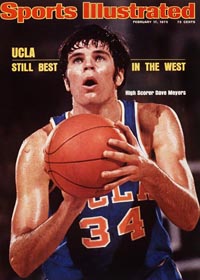
Dave Meyers
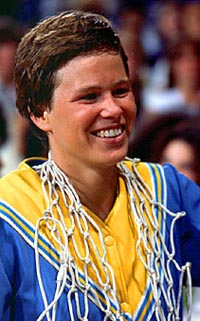
Ann Meyers
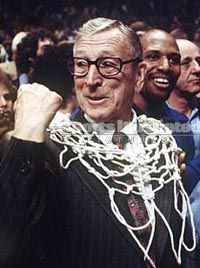
John Wooden after coaching his last game
Back to Top
|
Reference: "Where Are They Now? Dave Meyers," Official Program of the NCAA First/Second Rounds in New Orleans 2010
|
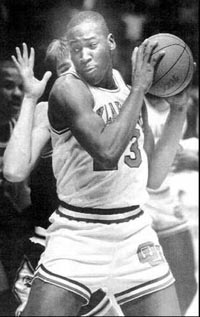
Wayman Tisdale, Oklahoma 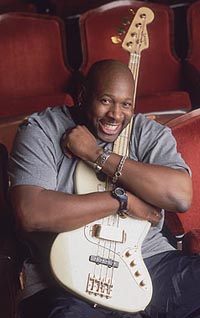
Wayman Tisdale, musician |
Wayman Tisdale, a star at Oklahoma and a 12-year NBA pro, died of cancer at age 44 in May 2009. He was also a "pro" in music as well.
- Wayman, the son of a Tulsa preacher, learned to play the bass guitar in third grade and played at his father's church. When Oklahoma coach Billy Tubbs recruited Tisdale, he agreed to move OU's Sunday practices to the evening so that Wayman could go to Tulsa to participate in services each Sabbath morning.
- Tisdale, who wasn't interested in basketball until eighth grade, played three years at OU. A 6'9" 240 lb PF, he made All-Big-Eight each season and became the first player to be named first-team All-American each of his first three seasons.
- He also won a Gold Medal with the 1984 Olympic team coached by Bobby Knight.
- Drafted in the first round of the 1985 NBA draft by the Pacers, Wayman played 12 seasons with Indiana, Sacramento, and Phoenix. He averaged 15.3 ppg and 6.1 rpg for his career.
- In 1997, Tisdale became the first OU athlete in any sport to have his number (23) retired. Blake Griffin received Tisdale's blessing to wear 23 during his recent All-American career in Norman.
- Waymon's first album, appropriate titled Power Forward, sold a quarter of a million copies in 1995. He characterized his style as "church/gospel/country/funk."
- He eventually released eight albums. His 2001 number Face to Face rose to #1 on Billboard's Contemporary Jazz list.
- In 2007, Tisdale's right leg snapped as he walked down the stairs in his home. Doctors amputated it in August 2008 after finding a cancerous cyst.
- Waymon got a prosthetic limb and returned to his music. His last album, Rebound, was inspired by his battle with cancer.
|
One of the most tragic incidents that ever occurred on a basketball court was the death of Loyola Marymount senior Hank Gathers on March 4, 1990.
- As a junior, Gathers averaged 32.7 ppg and 13.7 rpg, both tops in the nation, making him only the second player to lead in both categories in the same season.
- The next year, he was a candidate for Player of the Year and projected as a lottery pick in the next NBA draft.
How did a boy raised in the projects of North Philadelphia make it to a small Catholic college in California?
- From the age of 12, Hank dreamed of playing in the NBA.
- He and his friend Bo Kimble led Dobbins Technical High School to the Philadelphia public school championship.
- Coach Stan Morrison recruited the inseparable duo to USC. However, after one year, Morrison was fired and the Philly boys transferred across town to Marymount.
Both blossomed in Coach Paul Westhead's full-court press, 3-point barrage, up-tempo system.
- Over the next three years, Loyola Marymount was involved in the five highest-scoring games in NCAA history.
- The Lions finished Bo and Hank's sophomore season with a 19-10 record. As West Coast Conference tournament champions, LMU qualified for the NCAA Tournament for the first time in school history. They defeated Wyoming 119-115 in the first round before losing to North Carolina 123-97.
- The 20-11 Lions made the NCAA tournament again in 1989. They downed Santa Clara 75-70 in the first round but lost to Arkansas 120-101.
- The next year went even better. The Lions won 23 games and lost only five as they won the regular season WCC championship.
Gathers' first sign of trouble came on Saturday, December 9, 1989.
- He collapsed at the FT line during a home game against UCSB.
- Doctors found he had an abnormal heartbeat and prescribed a beta blocker.
- However, Gathers soon cut back on his dosage because the medication adversely affected his play.
The Lions played Portland State in the first round of the conference tournament on the fateful night.
- With about 13 minutes left in the first half, Hank scored on an alley-oop tomahawk dunk that put the Lions up 25–13.
- Running down the court, he slapped hands with PG Terrell Lowery who had thrown the pass, then collapsed.
- Gathers attempted to get up, telling the trainers, "I don't want to lay down!", then fell back and soon stopped breathing.
- He was declared dead on arrival at a nearby hospital at the age of 23.
- The rest of the WCC Tournament was cancelled and Marymount declared the conference's representative in the NCAA tournament.
Gathers was buried in Philadelphia five days later.
- An autopsy found that he suffered from a heart-muscle disorder, hypertrophic cardiomyopathy.
- Gathers's parents eventually sued LMU for $32.5M. The school settled out of court for $1.4M.
What happened in the two weeks following Hank's death is one of the most inspiring stories in basketball history.
- The NCAA opportunity provided the LMU team and coaches an escape from grief.
- The Lions defeated New Mexico State 111-92 in the first round. The first time he got fouled during the game, Kimble shot the first FT left-handed to honor his fallen teammate. Gathers had been right-handed also but, struggling with his FT shooting, had shot left-handed for awhile. When Kimble made the shot, he sealed his action as one of the most memorable moments in sports history.
- Kimble made his first FT left-handed in Marymount's 149-115 victory over Michigan in the second round that sent the Lions to the Sweet Sixteen.
- Alabama succeeded in slowing down the Lions but still lost 62-60. Bo continued his streak of lefty FT success.
- The incredible run came to an end at the hands of eventual champion UNLV 131-101 in the Elite Eight. Kimble never shot a FT in this game.
Bo began a three-year NBA career the following season.
- He stayed in L.A. to play for the Clippers for two years.
- He moved back East in 1992-3 to join the Knicks.
- For the first part of his pro career, he continued to shoot his first FT in each game southpaw.
- Bo established a non-profit foundation, Forty-four for Life, to honor Gathers' legacy. The organization raises money to donate defribillators and educate people about sudden cardiac arrest.
|
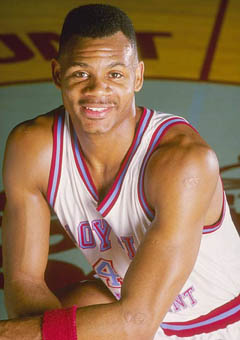
Hank Gathers
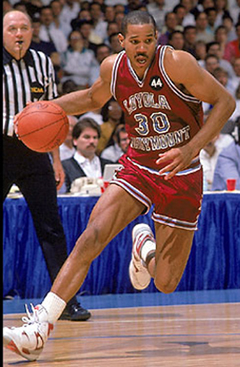
Bo Kimble
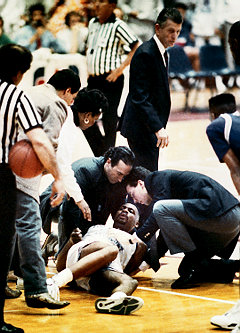
Hank Gathers after his collapse with Coach Paul Westhead standing in center of picture.
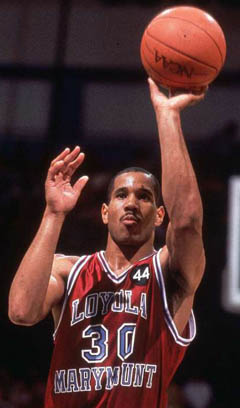
|
Reference: "20 years later, Gathers' legacy endures," New York Times, March 4, 2010
Back to Top
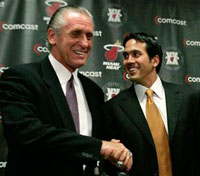
GM Pat Riley introduces his new coac h

Erik Spoelstra
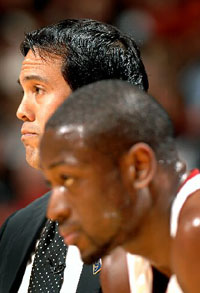
Coach Spoelstra with Dwayne Wade
|
If you're like me, you wondered why GM Pat Riley chose Erik Spoelstra to coach the Miami Heat for the 2008-9 season. And then you were puzzled again when he remained as the coach after superstars LeBron James and Chris Bosh joined Dwayne Wade to form the Big Three for the 2010-11 season.
- Erik's father Jon served as an NBA executive for four teams, including the Portland Trail Blazers. Erik's mother is Filipino.
- Spoelstra hadn't played in the NBA and his college career took place at Portland University, a not particularly well-known Catholic college in the West Coast Conference. After graduation, he spent two years in Germany as player-coach of a pro team.
- With his sights set on coaching in the U.S., Erik applied to numerous colleges for a low-level position but got no response.
- When the Heat offered an entry-level job helping with draft preparation, he snapped it up. "I figured maybe an internship for the summer would give me some experience and help the resume a little bit," he says.
Spoelstra's work ethic impressed the Heat staff.
- He first spent long hours in "The Dungeon," a windowless storage room in the old Miami Arena, trying to master the new video technology under the guidance of a trainer from the software company. "I remember one particular day, I was struggling, just messing up, freezing the software. The guy got so frustrated, he said, 'You're an idiot,' and left the office."
- When Erik got the hang of it, he provided new head coach Riley and assistant Stan Van Gundy with precise analyses of what was working and not working for the Heat on both ends of the floor.
- To keep up with the workload, Erik slept in The Dungeon several times a week. He often drove his old station wagon in the middle of the night to deliver game film to the airport for shipment to the club's next destination.
Erik's effort paid off as he began to work his way up the coaching ladder.
- After two years, he became an assistant coach/video coordinator. Two years after that (1999), he became assistant coach/advance scout.
- In 2001, his title changed to assistant coach/director of scouting. He contributed to Miami's surprise 2006 NBA Championship.
During this period as an assistant, Erik gained a major ally in Heat star Dwayne Wade.
- Wade struggled with his jump shot in his first two NBA seasons.
- Spoelstra worked with Dwayne incessantly. "We worked a lot of hours," Wade says. "You saw that he knew the game and was a hard worker. He gave me the confidence to think, I can do it."
- The effort paid off on November 19, 2004, when Wade sank the winning basket as time expired in OT against the Jazz. "It was the exact shot we'd been working on," Dwayne says. "I hit the game-winner, and I remember looking over at him, smiling and thinking, 'This is working.'"
When Riley retired as coach, he had no doubt Spoelstra was the man to take over.
- Pat said at that time, "This game is now about younger coaches who are technologically skilled, innovative, and bring fresh new ideas. That what we feel we are getting with Erik Spoelstra. He's a man that was born to coach." Riley added, "A lot of players want the discipline; they will play for Spoelstra, because they respect him."
- Van Gundy adds, "Very early in his career, we all knew he'd end up where he is. I don't think anyone is surprised that he's gone to that level. Erik might say he's surprised, but no one else in that organization is."
- At age 37, Spoelstra became the youngest head coach in the league. He took the Heat from the worst record in the league (15-67 in '07-08) to a 43-39 mark in his first season. The team has increased its number of wins the next two seasons (47-35, then 58-24).
Reference: "Upwardly Mobile," Kevin Arnovitz, ESPN the Magazine, 5/2/2011
Back to Top
|
If Perry Wallace was destined to be the Jackie Robinson of SEC basketball, neither his coach nor anybody else at Vanderbilt played the role of Branch Rickey.
- Growing up in segregated Nashville, Wallace was All-City, All-Region, and All-State at Pearl High School, which went undefeated (31-0) and won the state championship in the first year of integrated play in Tennessee. Pearl had a tradition of sending outstanding basketball players to predominantly white colleges, including two members of Loyola of Chicago's 1963 NCAA Championship team.
- Add valedictorian to his credentials, and Wallace became attractive to many colleges, including top basketball schools like UCLA. He had no dream of playing major college ball in the south because all teams were lily white in the SEC and ACC. He visited Michigan, Purdue, Northwestern, and Iowa of the Big Ten. In the SEC, Vanderbilt and Tennessee coveted his talent.
- Vanderbilt coach Roy Skinner, fresh off the school's first SEC championship in 1964-65, had been recruiting black players since the school accepted black undergraduates two years earlier but had been unable to convince any to break the color barrier in the SEC.
- Wallace later explained his selection: Here is a great magical secret on how Coach Skinner got me to Vanderbilt. He came over and said "Hello." He talked to my parents and me. He showed me he was a person. We were pretty down home. My parents grew up on a farm, then they came to Nashville. We liked people to sit down and look you in the eye and talk. Just tell you they're very interested and sincere in talking business with us. It's not like there was some great formula from physics.
- It helped that Skinner also signed another black player, Godfrey Dillard from Detroit. But after he went through the tough freshman season with Wallace, an injury kept Dillard from playing as a sophomore, leaving Perry to take the brunt of the abuse as the first black player in the SEC. (Dillard would transfer and never play a varsity game for Vanderbilt.)
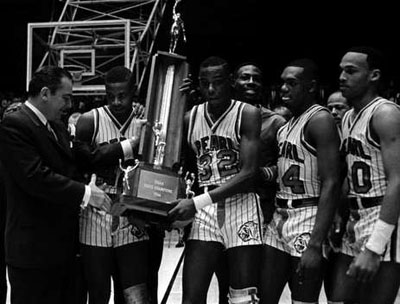
Pearl High School wins first integrated Tennessee championship.
Wallace is the first player on the left.
Skinner admits that he gave no thought to the pressures Wallace would face.
The catcalls and the things at the games, I just hadn't anticipated anything like that. To me [having an African-American player on the team] wasn't a big deal, and I was surprised that it was at some of the other places. I shouldn't have been.
- But if Skinner had handpicked Wallace to be the pioneer, as Rickey did with Robinson, he couldn't have made a better choice. He was very even-keeled and always thought things through, says Skinner. The way he conducted himself commanded respect.
- Asked if he gave any thought to Wallace's personality when recruiting him, Skinner admitted, No, I wasn't that smart. It just happened. I just recruited a good basketball player and a good person.
- Ole Miss cancelled the game between its freshman team and the Vandy frosh, claiming a scheduling problem. But everyone knew the real reason was that Vanderbilt had black players.
- The baby Commodores did travel to Starkville where Mississippi State Coach Babe McCarthy had just defied state lawmakers by sneaking his team out of the state to play against integrated teams in the 1963 NCAA tournament. The reception that gave Wallace a preview of what was coming throughout the conference: This was straight racism with enthusiasm. People are enthusiastic, screaming and hollering anyway. But unfortunately what also was part of the mix were all the name-calling and the threats. Whenever I made any mistakes they cheered. Anything that looked like a failure. They really wanted me to fail and they ridiculed, bullied and badgered me. They would have cheerleaders lead cheers just against me.
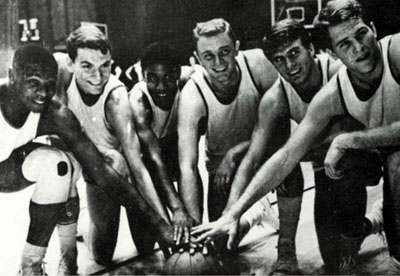
1966-67 Vanderbilt Freshman Team
Wallace at far left and Godfrey Dillard third from left.
Vanderbilt finally made the dreaded trip to Oxford in 1968.
- A boisterous crowd of 8,500 made the arena "a hellish, hellish place" in Perry's words. Football has more people in the stands, but basketball crowds are on top of the court.
- The Rebel fans threatened to lynch him, beat him, castrate him. They pelted him with objects. I got spat on at halftime by four generations of one family, Wallace recalled.
- The lack of sensitivity from his coaches and teammates became evident when the team returned to the court after halftime, leaving him behind to get treatment for a bloodied scalp from an opponent's blow in the first half.
- I looked out the door and I saw our team warming up, and I could hear the catcalls. You could hear the catcalls over the radio, people told me. They were hollering, "Where's the nigger? Where's the nigger? Is he scared? Did he quit?" I stood there and looked out, and I said, "Who is on my side?"
- I could get shot. I would worry about it. Whether it was founded, you didn't know. ... You know that there are a bunch of people that would love to see you die.
- Even Perry's white roommate, Bob Warren, didn't have a clue as to what was going on. I'm sorry to this day that I didn't understand to the degree that I do now. I'm very sorry that I couldn't be more of an encouragement to him, because it was tough. When he was around me, he didn't give any indication, through what he expressed verbally, that there was a whole lot going on there. He never, not once, as a roommate said anything negative to me about anybody. And he was very quiet, just a gentleman.
- Fortunately, Wallace's family was supportive throughout the tumult. They knew most of what he was experiencing, but not all. He kept the worst parts from them. They did not go to the road games, and I did not want them to go to the road games. ... Sometimes on the radio you could hear the catcalls from the crowd [but] that doesn't begin to give you a flavor. And they got letters. From the time I agreed to sign, we had letters and phone calls from people who were threatening death and those things. They had letters that I had never seen until a few years ago.
|
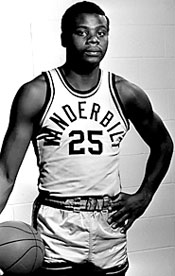
Perry Wallace
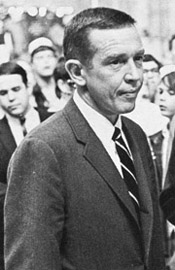
Coach Roy Skinner
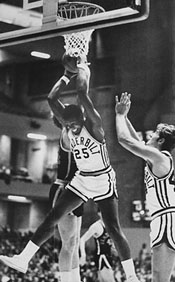
Wallace doing what he did best
- rebounding
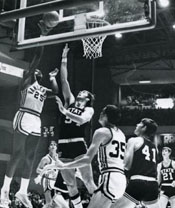
Wallace scoring in Memorial Gym at Vanderbilt
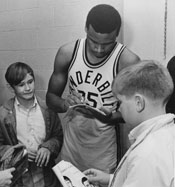
Wallace signing autographs
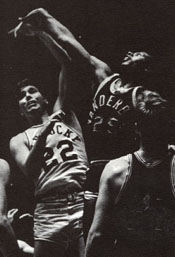
Wallace in action at Kentucky
|
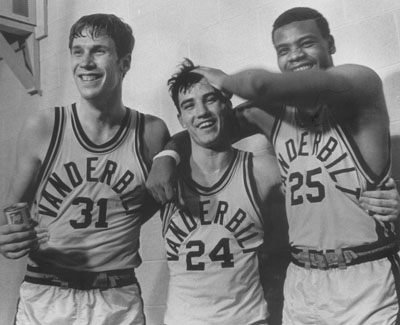
Perry Wallace with teammates

Professor Perry Wallace

Ceremony retiring Wallace's jersey
|
Wallace responded with one of the better halves of his career that night in Oxford.
- Skinner complained to the SEC office about the abuse Wallace was receiving during games. Roy also felt that the referees were calling goal-tending too much.
- Through it all, Perry kept his composure. I needed to be a model person. That's what a racial pioneer has to do. Everything has to be perfect nd proper as best as it can. Your behavior has to be exemplary. So things like complaining, yelling back at the crowd, yelling at the players, expressing frustration was something I couldn't do. I was also smarter than that. I knew that if I expressed frustration, or got into a tiff with the referees, that I would spark an additional surge above and beyond the things that were going on with the crowd.
- It wasn't just the Mississippi schools that were bad. Auburn, Alabama, and LSU were just as intimidating. Wallace recalls, Kentucky was probably the best, but not perfect. I always attribute that as maybe it was the most northern school in the south. A part of it was due to their culture of sports and basketball. Coach Rupp obviously ran a tight ship. The players didn't call you names. They didn't try to give you an extra elbow or push. These were excellent players and they were coached with high standards.
- Playing F and C at 6'5", Wallace, who could dunk a basketball in eighth grade, led the Commodores in rebounds all three years of varsity play and made all-conference as a senior. He made the 1,000-point club by 10. He remains second all-time in rebounds at Vanderbilt, averaging 11.5 per game. I wasn't a great shooter or ball handler, but I grew during my years. That is an angle that I try to shed some light on. To be under that type pressure and have to deal with the embarrassment of not being perfect. I had to improve under that type pressure. That's one of the things I was most proud of. They didn't recruit me because they needed somebody who was black. That was the wrong formula and would not have worked.
- Most important of all, Perry was voted Vanderbilt's most popular student as a senior.
As segregationists feared, letting one black player take the court opened the floodgates although it took a while.
- Wallace faced only one African-American from another SEC school, Auburn's Henry Harris.
- But within four years of Perry's 1970 graduation, more than half of SEC basketball recruits were black. In 1977, Alabama won the conference title with an all-black starting five. And by 1978, eight of ten SEC schools had at least three black starters with 83% of the league's recruits being African American.
Wallace was taken by Philadelphia in the fifth round of the 1970 NBA Draft, but he wasn't interested in pro ball.
- After receiving a degree in Electrical Engineering, he went to law school at Columbia.
- Since 1993, he has been a Professor of Environmental, Business, and International Law at American University in Washington D.C.
- He returned to Vanderbilt in 2004 to join Clyde Lee as the only two men's players to have their jerseys retired.
Reference: Across the Line: Profiles in Basketball Courage, Tales of the First Black Players in the ACC and SEC, Barry Jacobs (2008)
" Wallace was first black player in SEC," Bill Traughber,
vucommodores.com (2013)
Back to Top |
| |
As Anthony Davis entered his senior year of basketball in 2010, Michael O'Brien wrote in the Chicago Sun Times:
The Chicago Sun-Times covered nearly 700 boys high school basketball games last season. Anthony Davis, who just might be the best high school player in the country, didn't play in any of them.
- How could a player go from unnoticed his junior year to the most sought-after talent as he started his senior season?
- First, Davis improved by leaps and bounds during that period.
- Secondly, his school, Perspectives Charter, played in the Chicago Public High School League's "Blue" Division, considered the lower level of competition.
Anthony was a late bloomer.
- An opposing coach said of Davis, Most of the coaches on the South Side knew him as the little guy who would shoot threes from the corner in junior high. There weren't schools dying to get him on their team.
- The 3-point shooter grew to 6' by the end of his freshman year, 6'4" as a sophomore, and 6'7" to start his junior year. Suddenly, coaches took notice.
- The Davis family considered transferring Anthony to a basketball powerhouse like Hyde Park.
- But the coach there, Donnie Kirksey, a friend of Anthony Davis Sr., advised otherwise. I told him to leave his son where he was, that he would be fine. He's a solid kid. If you're good enough, they'll find you wherever you are.
- Davis grew to 6'10" by the end of his junior season, but he still didn't attract that much notice. Perspectives finished the season 8-15 despite a stellar season from Anthony. Only Cleveland State offered him a scholarship.
- In April 2010, he joined the club team Meanstreets. After playing nationally with the team in the spring and summer, Davis rose to one of the top three players in the class of 2011. NBADraft.net projected him as the sixth pick in the 2012 draft.
- As he prepared to return to high school for his senior season, Anthony recalled, During the high school season, no one knew I existed. I knew I could play. I haven't been intimidated this summer. Things have gotten intense, but it's been fun.
Davis's background as a point guard in junior high made him a big man with unique talents.
- Recruiting analyst Joe Henricksen said, I didn't want to go over the top after seeing him just one time. But after multiple times watching him play at various events, it became abundantly clear that he was one of the best players in the country. He's 6'10" and is incredibly skilled at passing, hitting a three and a soft mid-range jumper, and he can absolutely disrupt things defensively with his length and timing.
- In just a few months, Davis went from a marginal player with a single offer to one sought by dozens of schools.
- He made his decision about a college before beginning his senior year at Perspectives. It became a question of how and when to announce his choice.
- Davis Sr. in early August: Anthony knows where he wants to go, but we just aren't sure how to let everyone else know at this point. He's mentioned wanting to do it on television.
- The process became complicated when the Sun-Times published stories citing three different sources who alleged Anthony Davis Sr., following the lead of Cam Newton's father, was asking for between $125,000 and $200,000 in return for his son's commitment.
- Davis Pere denied the allegations and told the Chicago Tribune that his son had orally committed to Kentucky. The family also planned to file a suit against the Sun Times.
- Everything he printed was false, Davis Sr., said of O'Brien. I never asked anyone for any money for my son's commitment to any school. No one offered us anything, either.
- The charges had little impact on Anthony Jr.'s decision. It kind of bothered him a little bit, said his father. I think people put rumors out there to sway him from Kentucky.
- Meanwhile, the Sun-Times stood by its original stories but removed from its sports web site an article claiming Davis had agreed to go to Lexington for $200,000.
|
Even with a much improved Davis leading the way, Perspectives lost their first six games his senior season.
- He tallied a near quadruple double in the next game - 32 points, 21 rebounds, 11 assists, and 9 blocks. That was enough to give his team their first victory.
- But the season continued poorly, in part because Anthony missed some games with a sprained right thumb.
- After going 5-18 in the regular season, Perspectives won a regional play-in game in the Illinois High School Association playoffs before losing the regional semifinal game.
- Even with his growth spurt, Anthony continued to perform much like a guard by bringing the ball up the court and shooting outside shots.
- Final averages for his senior year: 32 points, 22 rebounds, 7 blocks.
- McDonald's chose him for its All-American Game. He also played in the 10th annual Jordan Brand Classic.
- After not being rated in the Mr. Basketball USA poll to end the 2009- 10 season, he began his senior year fifth - the highest of previously unranked players.
- He finished the year ranked 4th behind Austin Rivers, Mike Gilchrist (Kidd-Gilchrist, one of his teammates at UK), and Bradley Beal.
The rest of the story is well known.
- Davis played one year for John Calipari at Kentucky, during which he led the Wildcats to the NCAA Championship.
- He won the men's college basketball awards Grand Slam: National Player of the Year, Defensive Player of the Year, Freshman of the Year, and #1 pick in the NBA draft.
Following his college season, Davis got an unexpected opportunity.
- A rash of injuries to players who had been on the 20-man Team USA roster resulted in Davis making the US team for the London Olympics.
- The team went undefeated and won the Gold Medal over Spain.
- Davis played in seven of the eight games. He averaged 3.7 points and 2.7 rebounds.
- But the chance to practice and play with LeBron James, Kevin Durant, Carmelo Anthony, Kobe Bryant, Chris Paul, and other pro players prepared to step right into the regular season in the NBA.
Anthony's rookie season with the New Orleans Hornets was disrupted by injuries as his body showed the wear and tear of playing all summer on the U.S. team.
- He suffered a concussion in his second regular season NBA game and missed the next two contests.
- A few weeks later, he missed 11 games with a "stress reaction" in his ankle.
- A sprained shoulder sidelined him in early March. Then April 10 he suffered a season-ending knee injury.
- Despite missing so many games, he made the 2013 NBA All-Rookie First Team and finished sescond in the Rookie of the Year voting.
- 2012-13 per game stats: 13.5 points, 8.2 rebounds, 1.8 blocks.
He stepped up his game the next season for the renamed Pelicans.
- He still missed 15 games.
- But all his stats increased: 20.8 points, 10.0 rebounds, 2.8 blocks (tops in the league).
- He made the Western Conference All-Star team and scored 10 points in 9 1/2 minutes during the game in New Orleans.
Davis played in international competition again in the summer of 2014.
- He was selected to the U.S. FIBA Basketball team for the World Cup in Spain.
- The U.S. team, though not as star-studded as the Olympics squad, swept all nine games, and this time Anthony started every game.
- He averaged 12.3 points and 6.6 rebounds.
His teammates, coaches, and opponents all remark on Davis's maturity as a player and person.
- He doesn't take a bad shot, says Pelicans coach Monty Williams.
- Kings C Ryan Hollins: He's not like Kobe or Carmelo, where you put together a [defensive] plan for him and say, "If he gets the ball in this area, it's a bucket." He doesn't hurt you in one place. He hurts you everywhere.
- Anthony genuinely loves to play basketball. He wasn't back in New Orleans 48 hours after the FIBA games in Spain when he was in the Pelicans facility going through his individual workouts.
- He has interrupted timeouts with comments like, Can you believe this is what I wanted to do all my life and now I'm actually doing it?
- Teammate Ryan Anderson: The reads, the timing, the motor, the way he always moves his body with a purpose. That's what's really special.
- In the annual preseason survey of GMs before the 2014-15 campaign, Davis finished tied with Durant for second behind James as player they would select first if starting a franchise.
Reference: " Anthony Davis, Time to Really Fear the Brow,"
Sports Illustrated, 12/8/14
Back to Top |
|
CONTENTS
Julius Erving - I
Julius Erving - II
Julius Erving - III
Dave Bing
Dave Meyers
Wayman Tisdale
Hank Gathers
Erik Spoelstra
Perry Wallace
Anthony Davis
Basketball
Magazine
Golden Rankings Home
|















































